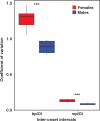Female indris determine the rhythmic structure of the song and sustain a higher cost when the chorus size increases
- PMID: 30697244
- PMCID: PMC6347063
- DOI: 10.1093/cz/zoy058
Female indris determine the rhythmic structure of the song and sustain a higher cost when the chorus size increases
Abstract
Among the behavioral traits shared by some nonhuman primate species and humans there is singing. Unfortunately, our understanding of animals' rhythmic abilities is still in its infancy. Indris are the only lemurs who sing and live in monogamous pairs, usually forming a group with their offspring. All adult members of a group usually participate in choruses that are emitted regularly and play a role in advertising territorial occupancy and intergroup spacing. Males and females emit phrases that have similar frequency ranges but may differ in their temporal structure. We examined whether the individuals' contribution to the song may change according to chorus size, the total duration of the song or the duration of the individual contribution using the inter-onset intervals within a phrase and between phrases. We found that the rhythmic structure of indri's songs depends on factors that are different for males and females. We showed that females have significantly higher variation in the rhythm of their contribution to the song and that, changes according to chorus size. Our findings indicate that female indris sustain a higher cost of singing than males when the number of singers increases. These results suggest that cross-species investigations will be crucial to understanding the evolutionary frame in which such sexually dimorphic traits occurred.
Keywords: chorus; coordination; duets; lemurs; singing; synchrony.
Figures



Similar articles
-
The Indris Have Got Rhythm! Timing and Pitch Variation of a Primate Song Examined between Sexes and Age Classes.Front Neurosci. 2016 Jun 14;10:249. doi: 10.3389/fnins.2016.00249. eCollection 2016. Front Neurosci. 2016. PMID: 27378834 Free PMC article.
-
Sexually dimorphic phrase organization in the song of the indris (Indri indri).Am J Primatol. 2020 Jun;82(6):e23132. doi: 10.1002/ajp.23132. Epub 2020 Apr 11. Am J Primatol. 2020. PMID: 32277718
-
Born to sing! Song development in a singing primate.Curr Zool. 2021 Mar 4;67(6):585-596. doi: 10.1093/cz/zoab018. eCollection 2021 Dec. Curr Zool. 2021. PMID: 34805535 Free PMC article.
-
Signal interactions and interference in insect choruses: singing and listening in the social environment.J Comp Physiol A Neuroethol Sens Neural Behav Physiol. 2015 Jan;201(1):143-54. doi: 10.1007/s00359-014-0938-7. Epub 2014 Sep 19. J Comp Physiol A Neuroethol Sens Neural Behav Physiol. 2015. PMID: 25236356 Review.
-
The multiple functions of male song within the humpback whale (Megaptera novaeangliae) mating system: review, evaluation, and synthesis.Biol Rev Camb Philos Soc. 2017 Aug;92(3):1795-1818. doi: 10.1111/brv.12309. Epub 2016 Nov 7. Biol Rev Camb Philos Soc. 2017. PMID: 28677337 Review.
Cited by
-
Who you live with and what you duet for: a review of the function of primate duets in relation to their social organization.J Comp Physiol A Neuroethol Sens Neural Behav Physiol. 2024 Mar;210(2):281-294. doi: 10.1007/s00359-023-01689-9. Epub 2024 Jan 29. J Comp Physiol A Neuroethol Sens Neural Behav Physiol. 2024. PMID: 38285176 Free PMC article. Review.
-
Isochronous singing in 3 crested gibbon species (Nomascus spp.).Curr Zool. 2023 Jul 3;70(3):291-297. doi: 10.1093/cz/zoad029. eCollection 2024 Jun. Curr Zool. 2023. PMID: 39035758 Free PMC article.
-
Rhythm and synchrony in animal movement and communication.Curr Zool. 2019 Feb;65(1):77-81. doi: 10.1093/cz/zoy087. Epub 2018 Nov 23. Curr Zool. 2019. PMID: 30697242 Free PMC article. No abstract available.
-
"The song remains the same": not really! Vocal flexibility in the song of the indris.Anim Cogn. 2023 Nov;26(6):2009-2021. doi: 10.1007/s10071-023-01826-6. Epub 2023 Oct 4. Anim Cogn. 2023. PMID: 37792125 Free PMC article.
-
Interactive rhythms across species: the evolutionary biology of animal chorusing and turn-taking.Ann N Y Acad Sci. 2019 Oct;1453(1):12-21. doi: 10.1111/nyas.14230. Epub 2019 Sep 12. Ann N Y Acad Sci. 2019. PMID: 31515817 Free PMC article.
References
-
- Altmann J, 1974. Observational study of behavior: sampling methods. Behaviour 49:227–267. - PubMed
-
- Bates D, MäChler M, Bolker B, Walker S, 2015. Fitting linear mixed-effects models using lme4. J Stat Softw 67:1–48.
-
- Boersma P, Weenink D, 2016. Praat: doing phonetics by computer (Computer program). Version 6.0.14 [cited 2016 March 2]. http://www.praat.org/.
-
- Bonadonna G, Torti V, Sorrentino R, Randrianarison RM, Zaccagno M. et al. 2017. Territory exclusivity and intergroup encounters in the indris (Mammalia: primates: indridae: indri indri) upon methodological tuning. Eur Zool J 84:238–251.
LinkOut - more resources
Full Text Sources
